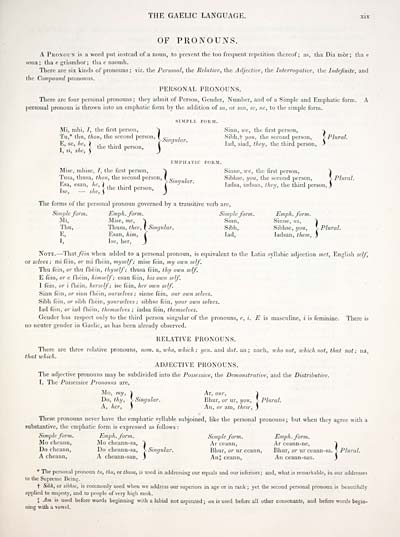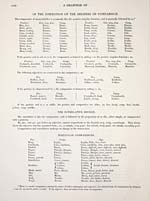Download files
Complete book:
Individual page:
Thumbnail gallery: Grid view | List view

1 u, iiiii, iiwu, iiie ^el;ullu pcisuii, ^ r. 7 .Tiun,T you, me seconu person, ;•.
THE GAELIC LANGUAGE. xix
OF PRONOUNS.
A PiioNouN is a word put instcnd of a nouti, to prevent the too frequent repetition thereof; as, tha Dia mòr; tha e
soiia; tha e gràsnihor ; tha c naomh.
There are six kinds of pronouns; viz. the Personal, the Relative, the Adjective, the Interrogative, the Jndejinite, and
the Compound pronouns.
PERSONAL PRONOUNS.
Tliere are four personal |)ronouns; they admit of Person, Gender, Number, and of a Simple and Emphatic form. A
personal pronoun is thrown into an ein[(luitic- form by the addition of sa, or san, sc, ne, to the simple form.
SIMPLE roRM.
Mi, mhi, /, the first person, "J Sinn, ive, the first person, -j
Tu,* thu, thou, the second person, ( ^. . Sibh,t you, the second person, y Plural.
EMPHATIC FORM.
Misc, mhise, /, the first person, ^ Sinne, ivc, the first person, Ì
Tusa, thusa, thou, the second person, ( „. , Sibhse, you, the second person, \ Plural.
fsT' *" — ' !he \ *'''= ^^""'^ 1'^''°"' ) '"^" '""' ^""^^^' ''*'^'""' ""^' ^^^ ^'"'"^ ^'''°"'
The forms of the personal pronoun governed by a transitive verb are,
Simple form. Emph. form. Simple form. Emph. form.
Mi, Mise, ine, "j Sinn, Sinne, us, "i
Thu, Thusa, thee, ( Simjular. Sibh, Sibhse, you, J. Plural.
E, Esan, him, C lad, ladsan, them, }
I, Ise, her, J
Note. — That /cm when added to a personal pronoun, is equivalent to the Latin syllabic adjection met, English self,
or selves ; mi fein, or mi fhein, jnyself; mise fein, my oivn self.
Thu fein, or thu fhein, thyself; thusa fein, thy own self.
E fein, or e fhein, himself; esan fein, his oivn self.
I fein, or i fhein, herself; ise fein, her own self.
Sinn fein, or sinn fhein, ourselves ; sinne fein, our own selves.
Sibh fein, or sibh fhein, yourselves ; sibhse fein, your own selves.
lad fein, or iad fhein, themselves ; iadsa fein, themselves.
Gender has respect only to the third person singular of the pronouns, e, i. E is masculine, i is feminine. There is
no neuter gender in Gaelic, as has been already observed.
RELATIVE PRONOUNS.
There are three relative pronouns, nom. a, who, which; gen. and dat. an; nach, luho not, which not, that not; na,
that which.
ADJECTIVE PRONOUNS.
The adjective pronouns may be subdivided into the Possessive, the Demonstrative, and the Distributive.
I. The Possessive Pronouns are,
Mo, my, "1 At, our, 'Ì
Do, thy, \ Singular. Bhur, or ur, ?/o!^ J P/«)-a/.
A, her, } An, or am, their, )
These pronouns never have the emphatic syllable subjoined, like the personal pronouns; but when they agree with a
substantive, the emphatic form is expressed as follows :
Simple form. Emph. form. Simpleform. Emph. form.
Mo cheann. Mo cheann-sa, Ì At ceann, Ar ceann-ne, Ì
Do cheann. Do cheann-sa, V Singular. Bhur, or ur ceann, Bhur, or ur ceann-sa. V Plural.
A cheann, A cheann-san, ) Anf ceann. An ceann-san. }
* The personal pronoun tu, thu, or thusa, is used in addressing our equals and our inferiors; and, what is remarkable, in our addresses
to the Supreme Being.
t Sibh, or sibhse, is commonly used when we address our superiors in age or in rank ; yet the second personal pronoun is beautifully
applied to majesty, and to people of very high rank.
I Am is used before words beginning with a labial not aspirated ; an is used before all other consonants, and before words begin-
ning with a vowel.
THE GAELIC LANGUAGE. xix
OF PRONOUNS.
A PiioNouN is a word put instcnd of a nouti, to prevent the too frequent repetition thereof; as, tha Dia mòr; tha e
soiia; tha e gràsnihor ; tha c naomh.
There are six kinds of pronouns; viz. the Personal, the Relative, the Adjective, the Interrogative, the Jndejinite, and
the Compound pronouns.
PERSONAL PRONOUNS.
Tliere are four personal |)ronouns; they admit of Person, Gender, Number, and of a Simple and Emphatic form. A
personal pronoun is thrown into an ein[(luitic- form by the addition of sa, or san, sc, ne, to the simple form.
SIMPLE roRM.
Mi, mhi, /, the first person, "J Sinn, ive, the first person, -j
Tu,* thu, thou, the second person, ( ^. . Sibh,t you, the second person, y Plural.
EMPHATIC FORM.
Misc, mhise, /, the first person, ^ Sinne, ivc, the first person, Ì
Tusa, thusa, thou, the second person, ( „. , Sibhse, you, the second person, \ Plural.
fsT' *" — ' !he \ *'''= ^^""'^ 1'^''°"' ) '"^" '""' ^""^^^' ''*'^'""' ""^' ^^^ ^'"'"^ ^'''°"'
The forms of the personal pronoun governed by a transitive verb are,
Simple form. Emph. form. Simple form. Emph. form.
Mi, Mise, ine, "j Sinn, Sinne, us, "i
Thu, Thusa, thee, ( Simjular. Sibh, Sibhse, you, J. Plural.
E, Esan, him, C lad, ladsan, them, }
I, Ise, her, J
Note. — That /cm when added to a personal pronoun, is equivalent to the Latin syllabic adjection met, English self,
or selves ; mi fein, or mi fhein, jnyself; mise fein, my oivn self.
Thu fein, or thu fhein, thyself; thusa fein, thy own self.
E fein, or e fhein, himself; esan fein, his oivn self.
I fein, or i fhein, herself; ise fein, her own self.
Sinn fein, or sinn fhein, ourselves ; sinne fein, our own selves.
Sibh fein, or sibh fhein, yourselves ; sibhse fein, your own selves.
lad fein, or iad fhein, themselves ; iadsa fein, themselves.
Gender has respect only to the third person singular of the pronouns, e, i. E is masculine, i is feminine. There is
no neuter gender in Gaelic, as has been already observed.
RELATIVE PRONOUNS.
There are three relative pronouns, nom. a, who, which; gen. and dat. an; nach, luho not, which not, that not; na,
that which.
ADJECTIVE PRONOUNS.
The adjective pronouns may be subdivided into the Possessive, the Demonstrative, and the Distributive.
I. The Possessive Pronouns are,
Mo, my, "1 At, our, 'Ì
Do, thy, \ Singular. Bhur, or ur, ?/o!^ J P/«)-a/.
A, her, } An, or am, their, )
These pronouns never have the emphatic syllable subjoined, like the personal pronouns; but when they agree with a
substantive, the emphatic form is expressed as follows :
Simple form. Emph. form. Simpleform. Emph. form.
Mo cheann. Mo cheann-sa, Ì At ceann, Ar ceann-ne, Ì
Do cheann. Do cheann-sa, V Singular. Bhur, or ur ceann, Bhur, or ur ceann-sa. V Plural.
A cheann, A cheann-san, ) Anf ceann. An ceann-san. }
* The personal pronoun tu, thu, or thusa, is used in addressing our equals and our inferiors; and, what is remarkable, in our addresses
to the Supreme Being.
t Sibh, or sibhse, is commonly used when we address our superiors in age or in rank ; yet the second personal pronoun is beautifully
applied to majesty, and to people of very high rank.
I Am is used before words beginning with a labial not aspirated ; an is used before all other consonants, and before words begin-
ning with a vowel.
Set display mode to: Large image | Transcription
Images and transcriptions on this page, including medium image downloads, may be used under the Creative Commons Attribution 4.0 International Licence unless otherwise stated. ![]()
| Early Gaelic Book Collections > Blair Collection > Gaelic dictionary, in two parts > (41) |
|---|
| Permanent URL | https://digital.nls.uk/79284641 |
|---|
| Description | A selection of books from a collection of more than 500 titles, mostly on religious and literary topics. Also includes some material dealing with other Celtic languages and societies. Collection created towards the end of the 19th century by Lady Evelyn Stewart Murray. |
|---|
| Description | Selected items from five 'Special and Named Printed Collections'. Includes books in Gaelic and other Celtic languages, works about the Gaels, their languages, literature, culture and history. |
|---|

